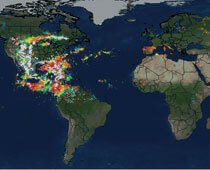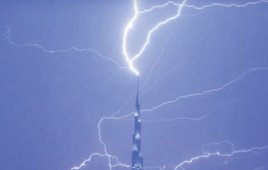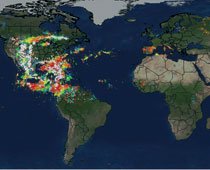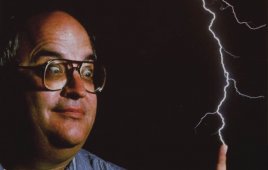With a record breaking count of 30, the northern hemisphere has seen more major hurricanes and typhoons of category 3, 4, and 5 in 2015 than in any previous season. Particularly vigorous activity in the Pacific, attributed partly to a potent El Niño, has made a major contribution. While Sandra became the strongest hurricane to…
Lufft’s new weather sensor is equipped with lightning detection
Lightning strikes can cause dangerous fires and lead to significant financial losses in the case of surge damage. This is especially true for wind turbines, solar panels, and smart grids, but it’s also relevant to building and power-plant insurance. The latest compact weather sensor from Lufft is providing a new form of lightning detection to…
A Halo for wind turbines protects them from lightning strikes
A RECENT INVENTION OUT OF SPAIN promises to eliminate lightning hits to structures such as wind turbines and stadiums. Cloud-to-ground lightning strikes when electric charges on earth and opposite charges in a storm cloud overcome the resistance provided by the air that separates them. “Rather than provide just a low-resistance path to ground, as existing…
Vaisala launches new thunderstorm tracking and lightning alert application
Vaisala has released the Thunderstorm Manager, a professional application for tracking approaching storms and warning of imminent threats from lightning for any location. Thunderstorm Manager combines data from Vaisala’s US National Lightning Detection Network (NLDN) and Vaisala’s GLD360, the network that delivers high-quality, truly global lightning coverage, to deliver comprehensive lightning information. With many thousands…
Damage control: Effects of near-lightning strikes on turbine blades
Allen Hall / President / Pinnacle Lightning Protection, LLC / www.pinnaclelightning.com Greg Shine / President / Shine Wire Products, Inc. / www.shinewire.com Lightning strikes the United States about 25 million times a year, according to the National Weather Service. That’s an impressive figure, and one reason why wind turbine owners and operators breathe a sigh…
Innovators 2013: Drs. E. Philip Krider, Martin A. Uman, Richard E. Orville, Kenneth L. Cummins, and Alburt Pifer
Pioneers of the National Lightning Detection Network The evolution of modern lightning-detection follows years of innovations in sensing technology and cooperation with industry and government labs. Its birth and commercialization, however, begins with two lightning scientists, Drs. E. Philip Krider (left) and Martin Uman. When they met at the University of Arizona in the late 1960s,…
Lightning-strike database spots trends, aids analysis
Vaisala has launched its Thunderstorm Total Lightning Database TLD100 and TLD200. These storage modules in the Vaisala Thunderstorm Information System archive cloud-to-cloud and cloud-to-ground lightning data. The TLD100/200 offers fast data collection, retrieval, and secure storage of processed lightning solutions for clients of the lightning detection system. The database is said to let lightning-network owners and…
Handling lightning on a North Dakota wind farm
North Dakota’s flat plains and strong, steady winds make it ideal for wind farms. But this part of the country is especially susceptible to extreme weather conditions. Summer brings the threat of lightning strikes to the 300-foot tall turbines and brutally cold temperatures are commonplace in winter. The Langdon Wind Energy Center operates a 133-turbine…
An alternative to copper-based grounding
Michael Mattera, Consultant, Bridgeport, Conn. commscope.com Wind turbine towers are a natural target for lightning strikes. A good grounding system plays a critical role guarding against catastrophic damage to the blades, electronics, transformer, nacelle, and collector system out to the substation. Up until now, copper has been the predominant material in wire and cable used…









